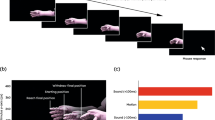Abstract
Lately, developers have attempted to explore the relationship between voice and visuals by creating various mappings between them. Hardly any developers, however, delved into forming physical mappings between voice and real objects. Programming non-verbal voice to control inanimate objects has yet to be implemented in highly interactive applications. This paper introduces the concept of Vocal Telekinesis to refer to the physical control of inanimate objects via paralinguistic vocal input. It highlights existing applications that could be considered forms of Vocal Telekinesis and presents some practical implementations of this concept. The aim is to expand the scope of interactive media through exploring various voice-physical mappings which will extend beyond the graphical output to include physical feedback such as changes in the size, brightness, speed, direction, and height of real objects.





Similar content being viewed by others
References
Al Hashimi, S., Davies, G.: Vocal telekinesis; physical control of inanimate objects with minimal paralinguistic voice input. In: Proceedings of ACM Multimedia 2006, Santa Barbara, CA, USA, 2006
Armand, A., Dauw, B.: Commotion. http://www.francobelgedesign.com/ (2004)
Borland, R., Findley, J., Jacobs, M.: Milliefiore effect. http://www.siggraph.org/artdesign/gallery/S02/onfloor/borland/1technicalstatement.html (2002)
Dobson, K.: Blendie 2000. http://web.media.mit.edu/%7Emonster/blendie/ (2003)
Dozza, M., Chiari, L., Horak, F.B.: Audio-biofeedback improves balance in patients with bilateral vestibular loss. Arch. Phys. Med. Rehabil. 86(7), 1401–1403 (2005)
Dyer F.L.: Edison, his life and inventions. http://www.worldwideschool.org/library/books/hst/biography/Edison/chap10.html (1929)
Gaver, W.: The sonic finder: an interface that uses auditory icons. Hum. Comput. Interact. 4, 67–94 (1989)
Gaye, L., Holmquist, L.E.: In: Duet with everyday urban settings: a user study of Sonic City. In: Proceedings of the New Interfaces for Musical Expression (2004)
Harada, S., Wobbrock, J.O., Landay, J.A.: VoiceDraw: a hands-free voice-driven drawing application for people with motor impairments. Proceedings of the 9th International ACM SIGACCESS Conference on Computers and Accessibility. Tempe, Arizona (2007)
Karpf, A.: The human voice. Bloomsbury, London (2006)
Kirschner, R., Morawe, V., Reiff, T.: ‘His Master’s Voice’, http://www.fursr.com/details.php?id=3&pid=3 (2001)
Liljedahl, M., Lindberg, S., Berg, J.: Digiwall—an Interactive Climbing Wall. In: Proceedings of ACE2005. Valencia, Spain, 15–17 (2005)
Ng, K., Popat, S., Stefani, E., Ong, B., Cooper, D.: Music via motion: interactions between choreography and music. In Proceedings for the Inter-Society for the Electronic Arts (ISEA) Symposium, France. http://www.isea2000.com/actes_doc/48_kia_ng.rtf (2000)
Patten, J., Recht, B., Ishii, H.: Audiopad: a tag-based interface for musical performance. In: Proceedings of the New Interfaces for Musical Expression (NIME ‘02) (2002)
Roosegaarde, D.: 4D-Pixel. http://www.daanroosegaarde.nl/ (2005)
Schmitt, A.: asFFT Xtra. http://www.as-ci.net/asFFTXtra (2003)
Snibbe, S.: Blow up. http://www.snibbe.com/scott/breath/blowup/index.html (2005)
Sørensen, K., Petersen, K.Y.: Smiles in motion. http://www.boxiganga.dk/english/enindex.html (2000)
Wakefield, J.: Body movement to create music. http://news.bbc.co.uk/2/hi/technology/3873481.stm (2004)
Zivanovic, A.: http://www.senster.com/ihnatowicz/ (2000)
Acknowledgments
I am infinitely grateful to Gordon Davies for his unstinting guidance and support throughout every stage of my Ph.D research and experience. Without his contribution to the development of the source code none of my projects could have been completed. I am exceedingly grateful to Stephen Boyd Davis and Magnus Moar for their lavish assistance and supervision. I am indebted to Nic Sandiland for teaching me the necessary technical skills to bring Expressmas Tree to fruition. I am indebted to The University of Bahrain for sponsoring my studies and granting me the opportunity to pursue my postgraduate degree. I am very thankful to Sahar Sabri, instructor at Bahrain Al-Shamil Rehabilitation Center and to all those who participated in my evaluations.
Author information
Authors and Affiliations
Corresponding author
Rights and permissions
About this article
Cite this article
Al Hashimi, S. Vocal Telekinesis: towards the development of voice-physical installations. Univ Access Inf Soc 8, 65–75 (2009). https://doi.org/10.1007/s10209-008-0135-y
Published:
Issue Date:
DOI: https://doi.org/10.1007/s10209-008-0135-y




